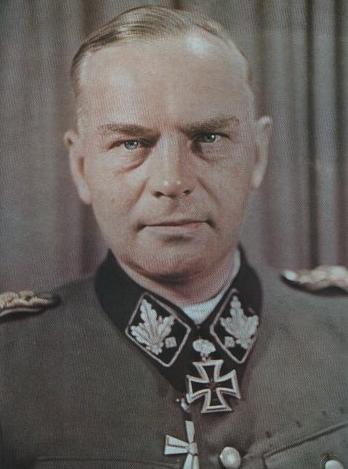Felix Martin Julius Steiner was born on 23 May 1896 in East Prussia. His military service began shortly before the Great War with his enlistment in the German Army. He was quickly promoted to NCO, and was commissioned in January 1915, less than a year after entering the service. He was assigned to Stosstrupp (“strike troop”) formations that broke the deadlock on the Eastern Front during the 1917 Riga campaign. He then participated in similar actions on the Western Front during the spring of 1918. He came away from the war convinced that such highly-trained, flexible units could be successful on a much greater scale in future warfare.
After service in a Freikorps in Lithuania, Steiner found a place in the Reichswehr, but retired as a Hauptmann at the end of 1933. He was frustrated by what he considered a lack of innovation, and sought a venue for his concept of an elite soldier-athlete. He first sought this through joining the SA, but on in April 1935, he switched to the SS. Here, with carefully screened volunteers under his leadership, he at last was able to demonstrate the validity of his ideas. The continued success of his training methods earned the approval of Paul Hausser, who spread them throughout the early units of the burgeoning Waffen-SS. Steiner also popularized the use of the camouflage smock, developed by his subordinate, Dr. Wim Brandt. Camouflage clothing later spread to the rest of the Waffen-SS and eventually to armies around the world.
Steiner’s regiment, SS-Deutschland, fought effectively in the invasions of Poland and Western Europe, and Steiner was one of the first Waffen-SS members to earn the Knight’s Cross on 17 June 1940. He was promoted to SS-Brigadeführer on 9 November 1940, and on 1 December assumed command of the newly-formed SS-Wiking Division. Here he discovered a phenomenon that became a personal cause for the rest of his life.
SS-Wiking included the recently raised SS-Nordland and SS-Westland Regiments. The former included volunteers from Norway and Denmark, while the latter had men from Flanders and the Netherlands. While many more traditional German officers were skeptical of the value of foreign volunteers, Steiner embraced them enthusiastically.
The Finns, Swiss, Swedes, Danes, Norwegians, and Flemings entrusted to him came to admire Steiner for his firm, but caring leadership. He became known for shaking hands with every man in formations drawn up for inspection, and for emphasizing military efficiency over politics. Steiner was reprimanded by Himmler on several occasions for downplaying SS and Nazi ideology, and also for never abandoning his Christian faith, but he retained his commands because of his military abilities. His influence extended to the officer corps of SS-Wiking, so that the foreign volunteers were always respected and well treated.
During the Caucasus campaign, Steiner assumed temporary command of the army’s III Panzer Corps (November 1942-January 1943). This was an unusual step, but he had earned the respect and cooperation of his Army colleagues, including General Staff officer Joachim Ziegler. Steiner earned the Oakleaves to his Knight’s Cross on 23 December 1942. He was marked for a permanent corps command, and this became official during May 1943, when he became the first commander of the III (Germanic) SS-Panzer Corps, which collected most of the available Western European volunteers.
The III (Germanic) SS-Panzer Corps fought very effectively during 1944 against heavy odds in the retreat from the Oranienbaum front to the Narva bridgehead, and finally on the Tannenberg defense line. Steiner received the Swords to his Knight’s Cross in recognition of this on 10 August 1944. Steiner continued to lead his corps until late January 1945, when he preceded it to Pomerania to organize an offensive. The scattered units available were given the grandiose title “11th SS-Panzer Army,” though they were below conventional army strength.
Steiner resumed command of the III (Germanic) SS-Panzer Corps west of the Oder River during April 1945, and soon after defied Hitler’s order to launch a hopeless relief attack on Berlin. The decision spared the lives of many of his men. Steiner intended to surrender all of the remaining Western European volunteers to the Western Allies, under the faintest of hopes that they might be used against the Communists in a post-war struggle.
In captivity, Steiner refused to testify against British volunteers who had joined the Waffen-SS. He later helped organize the Hilfsgemeinschaft auf Gegenseitigkeit der Soldaten der ehemaligen Waffen-SS (the HIAG, or Mutual Aid Society for Former Members of the Waffen-SS), and then devoted his time to writing studies of military history.
Steiner died in Munich on 17 May 1966.
